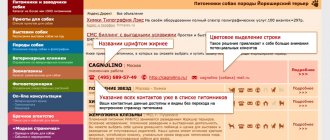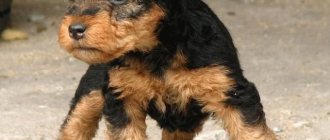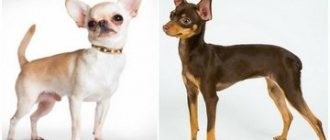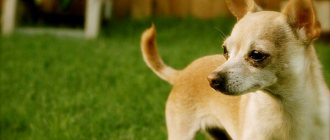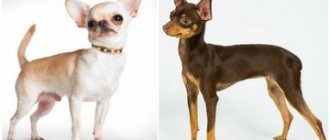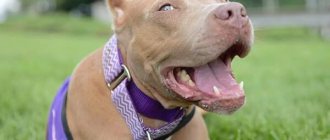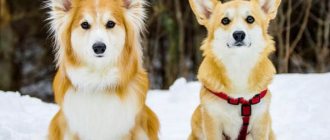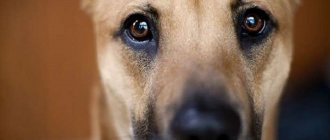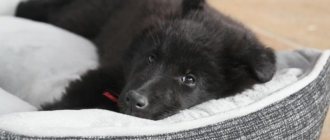Two dog breeds: the St. Bernard and the Moscow Watchdog are undoubtedly similar to each other, but this similarity is superficial. Upon closer examination, it turns out that the differences between them are significant. This especially applies to the character inherent in each breed variety.
Breed standard and description
Height at withers: males – from 68 cm, females – from 66 cm; Weight: males – from 55 kg, females – from 45 kg.
Color: red and piebald with white markings on the limbs, tail and body.
General appearance: dogs of a strong, rough type, without excessive dampness, with a muscular body. They are distinguished by their bright coat color and calm and confident expression in their eyes.
Disqualifying signs:
- cowardice, hyperexcitability;
- not a scissor bite;
- jaw distortion;
- not black nose, eyelids;
- incomplete dental formula;
- feminine males;
- amble;
- eyes green, blue or different colors;
- unbalanced movements;
- dewclaws, including those not surgically removed;
- cryptorchidism is complete or unilateral.
Differences between the Moscow Watchdog and the St. Bernard
The Moscow Watchdog, unlike the St. Bernard, has:
- Drier and stronger build;
- The transition from forehead to muzzle is not so pronounced;
- Guard qualities, healthy malice;
- A head of a different structure, a different expression of the eyes;
- Active behavior, quick reaction;
- Easier and freer movements;
- Tightly fitting eyelids and lips without sagging;
- Distrust of strangers.
The current standard specifies the desired color of Moscow watchdogs: dark mask, sable color (black edging on red spots), which is very rare among St. Bernards. In the St. Bernard breed standard, the lower height limit at the withers differs from similar values for Moscow watchdogs.
Moscow watchdog
Saint Bernard
Saint Bernard
These kind “giants” are direct descendants of Tibetan mastiffs, considered one of the most ancient dog breeds . There is a rather romantic and beautiful legend associated with the name of the breed: once upon a time, representatives of this type of dog, who lived in the monastery of St. Bernard, saved the lives of travelers who fell into snow traps in the harsh mountain conditions of the Alps and helped them reach the nearest human dwellings, get shelter, food and a warm hearth.
But in one particularly harsh winter, most of the dogs simply froze, which forced breeders in the 19th century to develop a new variety, which, thanks to its dense fur, could survive even in severe frosts. This is how improved St. Bernards appeared, and in this form they have survived to this day.
Most St. Bernards are quite high at the withers (from 65–70 centimeters and above), have a wide and large head, a large nose and prominent brow ridges. The dog's body is powerful, with developed muscles and long, even legs. There is only one characteristic color for this species - a white-brown palette. You can also recognize a St. Bernard by its brown eyes, coupled with skin that is slightly loose on its face.
Interesting! Saint Bernards, in addition to straight and hard fur that lies close to the body, have a warm undercoat, which allows them to not freeze even in really cold weather.
History of the breed
If you delve into history, you can learn about Medellan dogs . They were maintained by landowners and aristocrats. They are very similar to modern Moscow watchmen. The Medellians were depicted on photographs from the late 19th century, but after dispossession they disappeared. They were used for hunting bears, baiting cattle, and protecting land. Kuprin described this Russian Molossian in his work “Thoughts of the Peregrine Falcon about People, Animals, Objects and Events.” The author had his own Medellin, as evidenced by photographs from that time.
After the Great Patriotic War, the USSR needed its own breeds that would serve in any conditions. Selection work was carried out in the Red Star military nursery.
The leaders of this project were biologist N.A. Ilyin, Major General G.P. Medvedev. and the head of the nursery N.I. Bortnikov. Over the course of several years, experimental crossings of the following parent breeds were carried out:
- Caucasian Shepherd Dog;
- Saint Bernard;
- Russian piebald hound;
- German Shepherd;
- Mix of Caucasian Shepherd and Newfoundland.
The main ones were St. Bernard and Caucasian Shepherd. From the first they wanted to get docility, bright appearance, unpretentiousness to living conditions, and from the second breed - watchdog qualities, moderate aggression, ease of movement. The Russian piebald hound conveyed its quick reaction and ringing voice.
This cross breeding led to the recognition of the breed group in 1958. Then the description was given by the famous dog handler A.P. Mazower, where he wrote about the similarity of the resulting group with St. Bernards, but noted progress in breeding. Later, this fact was no longer found in the standards.
In 1985, Moscow Watchdogs received the status of a separate breed and the first official standard. Muscovites were taken to exhibitions, breeding shows, and OKD and ZKS were trained with them.
In parallel with the breeding of the Moscow Watchdog, specialists also worked on other breeds:
- Black Russian Terrier;
- East European Shepherd;
- Muscovy Dog;
- Diver.
In the 90s, the breed almost disappeared. By the end of the century, breeding resumed thanks to enthusiasts from Moscow, St. Petersburg, and the Krasnodar Territory. In the 2000s, the similarity of Moscow watchdogs became obvious. Today, the National Breed Club is actively pursuing recognition in the FCI.
These large, independent and capable dogs serve in security companies, guard personal plots and farms and delight their owners. In 2009, at the prestigious Eurasia exhibition, a male named Khazar won the “Pride of Russia” ring, which is considered a great achievement for a young breed of such dimensions.
The current standard for the Moscow Watchdog breed was published in 2008. It is significantly different from the previous version from 1998. Orslan is considered the founder of the breed.
Every year, a large event dedicated to May 9 is held on the territory of Red Star. On this day, thousands of dogs gather to participate in exhibitions. The organizers organize demonstration performances in which military personnel perform with trained dogs.
Price
A purebred St. Bernard puppy in a specialized official nursery will cost from twenty-five thousand rubles.
Naturally, depending on the pedigree and individual characteristics of the baby, its cost may vary and even exceed fifty thousand rubles.
As you understand, participation in international exhibitions is still not a threat, but pedigree still matters. Based on the character, behavior, susceptibility to diseases and allergies of the parents, you will have an idea of what to expect from their offspring.
To read: Pomeranian Spitz: tips for caring for your pet, life expectancy
Temperament and character
The Moscow Watchdog is a working dog with moderate viciousness , so they devote a lot of time to training. There are individuals that are dominant in character.
Positive qualities of Moscow watchmen:
- Living thinking;
- Fast decision making;
- Unobtrusiveness;
- Equilibrium;
- Ability to learn;
- Loyalty to the owner;
- Working quality is at a high level.
Negative features:
- Independence;
- Stubbornness.
Reviews
A few reviews:
“The Moscow watchdog copes well with its duties as a guard. This is both a friend and a watchman. The only disadvantages I can include are a stubborn character, slobberiness and a large amount of fur that needs to be cleaned daily.”
“We bought a St. Bernard puppy because, according to reviews, it is the best family dog. And we were able to verify this ourselves.
He is so attached to the children that when we sent them to kindergarten, our Barry became sad and sat near the front door until his little friends returned.
And then the noisy games immediately began.”
Dog and man
The Moscow Watchdog is suitable for self-confident people who value the strength and intelligence of a dog. They are excellent guards, prefer to be outside, and love work. They are of little use for sports due to their physique, working qualities and unique thinking, which is characteristic of all Molossoids. Most often, Muscovites are adopted by experienced dog breeders .
They are affectionate with children; they take cats and other pets under protection or have a neutral attitude. They can live in an apartment where they take up little space, but then a full and long walk is necessary. In the house they most often doze off in a familiar corner, but their sleep is light.
Whom to choose
Before you buy a pet, you need to decide what exactly it is for. A St. Bernard would be more suitable as a pet. To protect a private home, it is worth purchasing a Moscow watchdog. You also need to take into account that St. Bernards are easier to train. Therefore, they are better suited for beginners.
The Moscow Watchdog and the St. Bernard are dogs that look similar to each other. However, before you buy yourself one of these breeds, you need to understand in advance how they may differ, find out their pros and cons.
Maintenance and care
Conditions of detention
Muscovites are not afraid of frosts, showers and other weather phenomena. Thick coat with undercoat protects from getting wet and hypothermia. They do not need to be dressed for walks ; they love to sleep in the snow.
In addition, it is hot in the house for a street dog, and it cannot stay within four walls for a long time. Healthy and young individuals tolerate heat well, but it is necessary to set up a booth or a shaded place on the site and provide fresh water in large volumes.
When kept in an apartment, Moscow watchdogs are walked twice a day . A walk of 1-2 hours at a leisurely pace is sufficient. Puppies are walked more often, but by 7-8 months you can switch to a two-time regimen.
If the dog is in an enclosure or in free flight, then walks are also necessary for the proper development and psychological health of the dog.
Feeding
Diet for an adult dog:
- Meat and offal, except pork – 700-800 g per day;
- Buckwheat porridge, rice – 200-300 g per day;
- Fermented milk products – 3-4 liters per week;
- Sea and ocean fish – 1-2 times a month;
- Chicken egg – 1-2 times a week;
- Bones, treats – periodically;
- Seasonal vegetables and fruits - periodically.
For a puppy from 1 month of age, food consists of the following products:
- Finely chopped beef - daily;
- Cottage cheese, kefir - daily;
- Chicken egg yolk – once a week;
- Fish – once a week;
- Porridge – every other day;
- Goat's milk - in the first 3 months of life 2-3 times a week.
During the first feeding period, puppies are fed small pieces of beef, not minced meat. Then fermented milk products, cereals and other foods are introduced. From 8 feedings a day they gradually move to 2 feedings a day. Many adult dogs eat once a day and periodically unload on their own.
During active growth, give vitamin and mineral supplements, after examination and consultation with a veterinarian and the puppy's breeder.
Dry food is selected according to the weight, age and health status of the dog. Thus, high-protein food with large pieces is suitable for Moscow watchdogs. Suckling puppies are accustomed to ready-made food by soaking the granules in warm water or goat's milk. By 2 months they can chew dry food with their teeth without any problems.
The diet of a pregnant or lactating dog should not differ significantly from the diet of its puppies, so as not to disturb the digestion of small Muscovites.
Grooming
The wool of Moscow watchdogs is unpretentious; dirt is removed on its own over time. However, they can be washed 2-3 times a year with deep cleaning shampoo, without balms and conditioners. Muscovites are brushed once a week, a little more often during the molting period. You can use a slicker brush, a brush with long sparse teeth and a furminator, but be careful, otherwise the spine will be damaged.
Teeth, ears, and claws are periodically examined and treated, especially in areas where there is a risk of contracting piroplasmosis from ticks.
What is the difference
If we talk about external differences, then MS are somewhat smaller, their heads are not so wide.
The tail is saber-shaped and cannot curl into a ball, as is the case with their ancestors.
A defect of the factory breed is considered to be a poorly defined hock joint of the hind legs.
If a puppy is born with such a defect, it must be removed from further breeding, since it will produce offspring affected by the disease. Some of whom will remain disabled.
Alpine relatives should not have such problems.
A very important difference lies in character. If the St. Bernard is an unusually calm, good-natured bear cub, always ready to come to the aid of a person and incapable of even the slightest manifestation of aggression, then MS can be different.
The character of factory dogs varies depending on which genes take over. If it is more similar to the Caucasian Shepherd, then your pet will become a wonderful watchman. He will be able to stand up for himself and for his owner, show toughness and even be aggressive. Such a dog should be brought up correctly and in a timely manner, as they will be less amenable to training.
Another important difference is that Saint Bernards are recognized throughout the world. Their standards are registered by the International Canine Federation, while MCs are known only in Russia and this breed is not recognized by world cynologists.
As for maintenance, both dogs will be unpretentious and usually troubles only arise with long and thick hair during the molting period. You will have to spend a lot of time combing your pet and cleaning.
Education and training
For Moscow watchdogs, they do not require passing exams to determine working qualities or temperament testing, but it is advisable to pass OKD and ZKS if the dog is put under guard.
Guard duty begins when the pet is completely under control. Otherwise, an angry dog becomes dangerous. This applies to any breed.
Muscovites quickly learn the program, but do not welcome mindless repetitions of the same command. The dog will simply refuse to comply with the owner's demands. Like many Molossers, representatives of this breed rarely agree to wear fetch.
Clear advantages include their interest in protecting their own territory. They begin to guard strangers early; puppies from 7-8 months of age bark at strangers behind the fence.
In the city, a dog of this type can be trained and taken for walks, because Muscovites do not need too active games. The main task for them is to serve man, and their punishment is to be ignored by their beloved owner.
Metis of Alabai
Crossbreed with Caucasian
When crossing an Alabai with a Caucasian Shepherd, large, furry puppies are obtained. It is impossible to guess who the puppies will be more like, since with the same frequency both dogs that look more like Alabais and Caucasians appear. However, you should not expect any special surprises from this mating, since these breeds are very similar both in appearance and in purpose.
With a German Shepherd
In this case, you should be careful, since dogs are very different both in appearance and in character. Of course, most often these puppies take the best from their parents:
- from alabai - courage, courage, ability to protect oneself, territory and owners;
- from the German Shepherd - intelligence, activity, obedience and people-oriented.
Important! But at the same time, puppies can turn out to be very unpredictable, difficult to train and very aggressive or, on the contrary, very cowardly. Such features often appear when very bright psychotypes of both breeds are mixed, and then problems may arise when raising such a dog.
Appearance also varies greatly, but puppies are often very large and darker in color.
With husky
The puppies turn out very cute and fluffy. In body type they are more similar to the Alabai, but the color is often taken from the Husky. Due to the nature of the husky, the animals turn out to be kinder, more playful, and less aggressive towards strangers, but do not forget that everything is individual, and the puppy can, on the contrary, turn out to be unpredictable.
With Labrador
Alabai and Labrador mixes turn out to be very large, but still smaller than Alabai. They have a wider chest and a more Labrador-like behavior. That is, playful, very active dogs that easily get used to new people. The color is often fawn.
With a husky
It is almost impossible to predict what will happen from a mixture of these two completely different breeds. It is safe to say that these will be very large and hardy animals. Outwardly, such mestizos are still more similar to mongrels than to purebred dogs. By character they can grow up to be both brave and strong guards and affectionate and kind family members, in this case it all depends on the puppy’s upbringing.
Father - Cane Corso, mother - Alabai
Both breeds are working, strong, balanced. This crossbreed often produces very large puppies with smooth hair. The color of the dog is unpredictable, but most often dark. The muzzle is massive, square, the bridge of the nose is straight. Both breeds do a good job of guarding, so puppies often turn out balanced and easy to train.
With a mongrel
This mix can be very unpredictable. If the character of the Alabai is at least a little predictable, then with the mongrel it’s the opposite, the dogs are completely different. We can say with confidence that such mestizos will still look more like mongrels than stocky purebred dogs. Unforeseen character.
Still, mestizos are a matter of taste. Such dogs are definitely not suitable for breeding and exhibitions. Of course, they often get the best qualities from their parents, but do not forget that any mixed breed is an unpredictable pet, and it is unknown what qualities it may display. Also, when different breeds are mixed, their unique qualities are lost. If you want to be confident in your choice, then you should still pay more attention to purebred dogs.
Health and life expectancy
On average, Moscow watchdogs live 10-12 years . Common diseases in the breed:
- Dysplasia of the hip and elbow joints;
- Volvulus;
- Patella luxation;
- Obesity;
- Heart failure;
- Dermatological problems.
Official genetic tests are not needed to breed Moscow Watchdogs.
The most famous
We know about St. Bernards, for the most part, from literature and cinema, in particular from films such as “Beethoven”, “Felix the Family’s Best Friend” and many others. These works quite accurately reflect the remarkable character traits of a dog, such as kindness, love for people, and non-aggression.
But there are merits of St. Bernards that few people know about, because they don’t write books or make films about them. Thus, a dog named “Barry”, who lived at the beginning of the 18th century, is known for saving as many as 40 human lives during his short dog life of just 12 years.
Most of them were saved from the snow thanks to his keen sense of smell, but there were also those who were alive thanks to his physical strength and perseverance. For example, there is a known case when Barry independently pulled out a little boy from under an avalanche, and, grabbing him by the collar of his jacket, dragged him 5 kilometers to the nearest village.
Of course, there are other breeds of dogs to which people owe their lives, such as canine dogs that help defuse bombs or police shepherd dogs, but St. Bernards have so far saved the most human lives.
Breed photo
A selection of photos of the Moscow watchdog.

